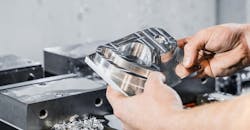Imagine a future where a designer simply states his or her parameters, and a machine spits out a part with every feature optimized. While we are far from full automation, the industry is well on its way toward making generative design a reality, where there are thousands of design permutations and a designer simply selects the best option.
One of the barriers to actualizing a generative future is the interaction between makers and manufacturers—those involved in the ideation stage versus those who work in production. In today’s manufacturing landscape, engineers and designers are accustomed to finding a factory and then connecting with someone who will analyze their part for manufacturability. While designers often know how to design for manufacturability (DFM) through years of experience, that knowledge can be difficult to impart to young designers. What “manufacturable” means can also change substantially between different processes, and even different factories.
For many years, DFM existed solely as ideas in textbooks, and sometimes those ideas failed to even make it onto paper. The notion of integrating software into the process to enhance and automate DFM was never seriously implemented. Today, it’s exciting to see the early development stages of automated DFM, and the implications are huge.
DFM software could suggest multiple approaches to the manufacturing processes you could use, or could even go all the way back to your design parameters. A designer could specify the amount and cost of a part, and the DFM software would recommend a specific process. More than being predictive, DFM automation will be suggestive.
Before we can fully integrate this type of automation into the manufacturing process, major changes need to occur in the way that designers, engineers and machinists interact. Here are three ways the industry can better equip itself to fully leverage the changes happening with DFM advancement:
1. Bridge the Information Gap between Manufacturers and Designers
Designers are isolated from the machines and people who make their parts. This segmentation between design and production presents a huge gap in knowledge, culture, and even geography. For machinists and design engineers to reach their full potential, both groups must collaborate and utilize new technologies to overcome the barriers that prevent hardware innovation.
There are specialized machinists who have been practicing for years who know everything about their process. But how do we translate their trade knowledge into software? That’s one of our key challenges now. There’s still too much knowledge that lives solely in machine shops.
Another large part of the problem is that most engineers aren’t aware of all the processes available for them. There are extensive books on the subject—like Manufacturing Processes for Design Professionals, which describes more 120 processes—but even those barely scratch the surface of what’s possible. Many individuals don't know, for example, what type of factory they should approach to make custom ball bearings. Before a designer can design for manufacturability, they have to know what types of manufacturing processes to even consider.
2. Involve Manufacturers in the CAD Software Development Process
Most companies that make CAD software don’t make machine tools or employ machinists. Inefficiencies arise when designers are unable to articulate their manufacturing needs. For example, an aeronautics company can demand that they want the brackets on the plane to be lighter while maintaining high strength, or they want a turbine blade to operate at higher temperatures and cooled from behind. But at the end of the day, those are just demands without any understanding of manufacturability. Someone else at a separate manufacturer has to think how they would develop a process to do that—and whether or not it would be feasible for them to do so.
Software has a huge role to play in providing transparency into the entire process. There are few companies that make software for machine shops to run machining tools. However, this divorce of software from machining hinders our ability to truly make progress in terms of building the types of products that we need for the future.
3. Create a Holistic Approach to Manufacturing
Prototyping companies can advance DFM by owning every part of the process, from the design to the end product. In Silicon Valley, programmers are pushed to be able to debug their applications in real time—the software equivalent of real-time manufacturability feedback. By developing an online platform that is connected via software to the factory’s operations, a smart factory can leverage the full potential of DFM. All of the back and forth of communicating with manufacturers leads to inaccuracies and huge potential losses.
Envision a future where you can ask your computer to debug your design and provide feature optimizations based on your parameters (which is how Plethora came about). When considering different DFM tools and software, it’s important for engineers to be able to connect with an actual manufacturer or factory that can carry out the job. Far too often, engineers get the entire way through a design only to realize that a base features is actually impossible to make.
As the processes and advancements in tooling and materials grow and become more complex, software will be the only solution to maintaining the level of speed and exact performance in machining parts.
Nick Pinkston is CEO and co-founder of Plethora.

